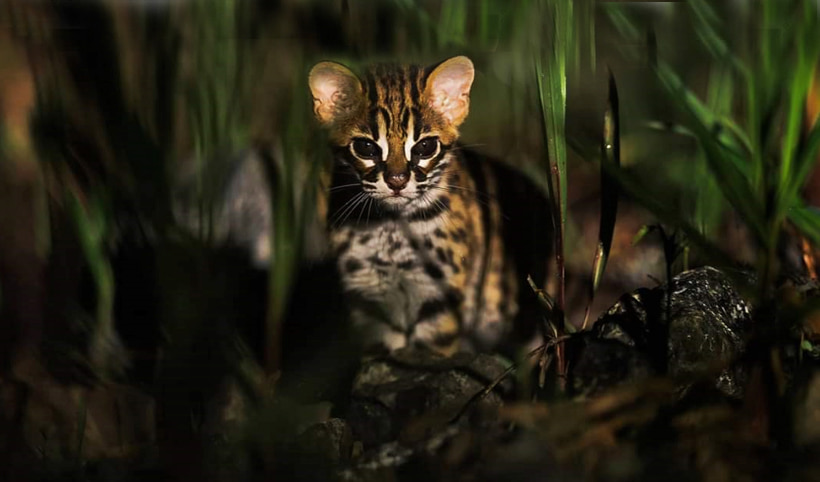How many leopards live in the Sundarban delta: I recently performed some studies and discovered that there are no leopards living in the Sundarban delta.
Indeed, the Sundarbans mangrove forest is the only tiger reserve in the world without leopards – the last leopard sighting in the Bangladeshi side of the territory was in 1931!

The reason for this is because the Sundarbans have the world’s greatest wild Bengal tiger populations (approximately 250-450 or more), much outnumbering the far more well-known Bandhavgarh, Bandipur, Panna, and Ranthambore National Parks.
Indeed, whenever tiger populations rise in certain areas, leopard populations fall – to the point where leopards are rare in habitats where tiger density is high, such as the Sundarbans –, except when prey is abundant or when the spotted cats hunt smaller game than their striped cousins – only then do tigers and leopards coexist peacefully.
How many leopards live in the Sundarban delta?

In 2012, camera traps that were placed in the Sundarbans provided evidence of a previously unknown species of feline, a small black cat with a long tail – it’s been established that this newly discovered animal is no leopard (meaning the Panthera pardus), but rather a small feline related to leopard cats (Prionailurus bengalensis) and fishing cats (Prionailurus viverrinus), one that got its black coat from melanism (just like black panthers).
Sundarban Animals
The Sundarban mangrove forest is the Royal Bengal Tiger’s single biggest habitat ( Panthera tigris ).
Sundarban is also home to the world’s sole tiger population, making it the world’s only mangrove forest with a tiger population. According to the 2004 census, there are roughly 274 tigers in the Indian Sundarban, with 249 in the Sundarban Tiger Reserve and 25 in the South 24-Parganas Forest Division, respectively. There are 58 mammalian species, 55 reptile species, and 248 avian species.
Sundarbans also has a number of rare and globally threatened animals, such as the Estuarine Crocodile (Crocodilus porosus), Fishing Cat (Felis viverrina), Common otter (Lutra lutra), Water Monitor lizard (Varanus salvator), Gangetic Dolphin (Platinista gangetica), Snubfin dolphin (Orcella brevirostris), River Terrapin (B ( Eritmochelys imbricata ). The Shark and Ray species found here are listed in Schedule I of the Wildlife (Protection) Act. Sundarban Reserved Forest is a natural biodiversity hotspot, according to their findings.
Avifauna:
There are 248 bird species in the region, with a substantial number of migrants from higher latitudes visiting in the winter. Herons, Egrets, Cormorants, Green Pigeons, Sand Pipers, Large and Small Spoonbills, Darters, Seagulls, Teal, Partridges, and a large variety of Wild Geese and Ducks inhabit the area.
Wild boars, spotted deer, porcupines, and Rhesus macaques are among the other animals. The venomous reptiles include the King cobra, common cobra, Banded krait, and Russells Viper, while the non-venomous snakes include the Python, Chequered Kil-Back, Dhaman, Green Whip Snake, and numerous more species.
Cetaceans:
The estuary rivers are home to cetaceans such as the Snubfin (Irrawady) and Gangetic Dolphin, with the former being more common. In the rivers surrounding the estuary, the Black Finless Porpoise (Necmeris porosus) may also be found. The Estuarine Crocodile, one of the most endangered and biggest crocodiles, finds refuge in the marshes and river. The estuaries are home to a diverse range of fish, mollusks, crabs, and prawns.
Periopthalmus sp. and Boleopthalmus sp. are two amphibious mud-skipper fish that have piqued people’s curiosity. Whale sharks, tiger sharks, hammerhead sharks, sawfish, guitar fish, and common edible fish such as Hilsa ilisha, Setipinna breviceps, Setipinna taty, and Gudusia chapra have all been spotted. The One-Armed Fiddler Crab (Uca spp.) and two species of trilobite (Tachypleus gigus and Carcinoscorpius rotundicauda) are common crustaceans.
The latter is also known as the Horse Shoe Crab, which is known as a living fossil and needs serious protection owing to its medicinal value and uncontrolled collection by quack doctors for commercial purpose.

Insects :
Insects abound in the woodlands, and the honey bee (Apis dorsata) is a significant source of revenue for poor people living on the outskirts.
The Sundarban Delta is the home of which animal?
1. Royal Bengal Tiger
2. One Horned Rhinoceros
3. Tibetan Wild Ass
4. Asiatic Lion

Hint:
A delta is a piece of land produced by river sediments as they merge into the sea at an estuary.
The Sundarban delta, located in the Bay of Bengal, is home to India’s national animal.
Complete answer:
The confluence of the rivers Ganga, Hooghly, and Brahmaputra forms the Sundarban Delta in the Bay of Bengal. It’s a mangrove wetland with freshwater. India accounts for about 40% of the marshy delta’s entire area. The remainder is Bangladeshi territory. These marshes shelter the locals from floods and storms brought in by the Bay of Bengal.
The Sundarban Delta is home to a diverse range of vegetation and wildlife. The area is characterised by mangrove forests of the Sundari tree. Sundarban gets its name from this tree, which is the main feature. Passur, kankra, and palms are among the other plant species present here. The region’s diverse biodiversity includes 270 bird species, 40 mammals, 35 reptiles, and 8 amphibians.
The Royal Bengal Tiger lives in the Sundarban Delta. The Royal Bengal Tiger can only be found in this mangrove habitat in Asia. It is the region’s most powerful predator. Monkeys and wild cats of various sorts are widespread in this area. It was also home to the Javan Rhinoceros, which became extinct in the Sundarbans in the mid-nineteenth century.
The saltwater crocodile, Russel’s viper, monitor lizard, electric ray, Indian python, and the notorious King Cobra all live in the Sundarbans.
2. One-Horned Rhinoceros: This is the wrong answer. They may be found in Assam’s Kaziranga National Park.
Read More:
This choice is wrong.
3. Tibetan Wild Ass: This option is incorrect. They live on the Tibetan plateau, in Ladakh, and in northern Nepal, near the Tibetan border.
4. Asiatic Lion: This is an invalid selection. They can only be found in Gujarat’s Gir Forest.
We have Sundarban Tour Packages Daily Basis.
For Booking Of Best Sundarban Package (Starting from 2799/-)

Royal Sundarban Tourism
Visit: https://tinyurl.com/y6smhoup
Contact: 7439965413 / 8584838109
Whats app link : https://tinyurl.com/yxtvhcs3
Email: info@royalsundarbantourism.comAddress: Sundarban. Gosaba Market Durga Mandir Road, Pin – 743370, West Bengal, India


